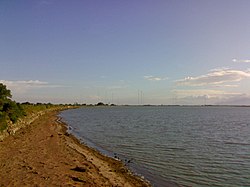| INS Kattabomman | |
|---|---|
| Tirunelveli, Tamil Nadu | |
 INS Kattabomman, VLF transmitting station of Indian Navy | |
| Site information | |
| Type | Naval station |
| Controlled by | Indian Navy |
 | |
| Site history | |
| Built | 1990 |
| In use | 1990–present |
| Garrison information | |
| Occupants | Southern Naval Command |
INS Kattabomman is the designation of the VLF-transmission facility of the Indian Navy situated at Vijayanarayanam near Tirunelveli in Tamil Nadu. [1] The facility spread over 3,000 acres has 13 masts, which are arranged in two rings around the central mast. The centre mast has a height of 301 metres, the masts on the inner ring measure 276.4 metres, that on the outer ring measure 227.4 metres. The facility broadcasts at frequencies of 16.3 kHz, 17.0 kHz, 18.2 kHz, and 19.2 kHz. [2]
Contents
Two further masts of the station carrying an umbrella antenna, the INS Kattabomman is 471 metres tall and the tallest structure in India. They are also the tallest military structure in the world. The facility opened an ELF transmission facility in 2014. [3] [4]
